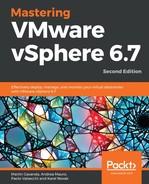- (b) False
- VLAN is a broadcast domain so that you can be segmenting Ethernet broadcast domains with VLANs. Network ports might be configured with one (access or untagged mode) or multiple VLANs (trunk or tagged mode).802.1Q trunking modifies Ethernet frames to add a numeric tag. Using this tag can forward frames to different VLANs.
- (b) False
- Inbound traffic shaping, Centralized management, PVLAN support, Netflow export support, Port mirroring, Multicast support, Traffic filtering, Network IO control, Enhanced LACP Mode.
- vSwitch, Port Group, VMkernel adapters, TCP/IP Stacks
- (b) Promiscuous mode, (c) MAC address changes, (e) Forged transmits
- (a) True
- (a) Active adapters, (c) Standby adapters, (e) Unused adapters
- (b) False
- (b) False
- CDP and LACP
- (a) MTU configuration, (b) VLAN configuration
- (a) True
- SR-IOV is a specification that allows a single Peripheral Component Interconnect Express (PCIe) physical device under a single root port to appear as multiple separate physical devices to the hypervisor or the guest operating system.
SR-IOV uses physical functions (PFs) and virtual functions (VFs) to manage global functions for the SR-IOV devices. PFs are full PCIe functions that are capable of configuring and managing the SR-IOV functionality. It is possible to configure or control PCIe devices using PFs, and the PF has full ability to move data in and out of the device. VFs are lightweight PCIe functions that support data flowing but have a restricted set of configuration resources.
 Chapter 7: Managing Networking Resources
by Karel Novak, Paolo Valsecchi, Andrea Mauro, Martin Gavanda
Mastering VMware vSphere 6.7 - Second Edition
Chapter 7: Managing Networking Resources
by Karel Novak, Paolo Valsecchi, Andrea Mauro, Martin Gavanda
Mastering VMware vSphere 6.7 - Second Edition
- Title Page
- Copyright and Credits
- About Packt
- Contributors
- Preface
- Section 1: Getting Started
- Evolution to vSphere 6.7
- Introduction to VMware vSphere
- VMware vSphere ecosystem
- Introduction to VMware Cloud on AWS
- What's new in VMware vSphere 6.7?
- Key features
- vSphere Client (HTML-5)
- Improved vCenter Server Appliance (vCSA) monitoring
- Improved vCenter backup management
- ESXi single-reboot upgrades
- ESXi Quick Boot
- Support for Remote Direct Memory Access (RDMA)
- vSphere persistent memory
- Virtual Trusted Platform Module (vTPM)
- TPM 2.0
- Microsoft virtualization-based security (VBS)
- Per-VM Enhanced vMotion Compatibility (EVC)
- Hybrid linked mode
- Instant Clone
- Configuration maximums
- VMware vSphere 6.7 Editions
- Key features
- Reasons for and against upgrading
- Summary
- Questions
- Further reading
- Designing and Planning a Virtualization Infrastructure
- Analysis and Assessment of Existing Environments
- Deployment Workflow and Component Installation
- vSphere components and workflow
- ESXi deployment plan
- ESXi installation
- vCenter Server components
- vCenter Server Appliance deployment
- vCSA HA
- Summary
- Questions
- Further reading
- Configuring and Managing vSphere 6.7
- Using the VMware vSphere HTML5 client
- Configuring ESXi
- Backing up and restoring ESXi
- Configuring vCSA
- Exporting and importing the vCSA configuration
- Managing data centers, clusters, and hosts
- Automating tasks with scripts
- Summary
- Questions
- Further reading
- Life Cycle Management, Patching, and Upgrading
- Section 2: Managing Resources
- Managing Networking Resources
- Basic network overview
- Virtual networking with switches
- Managing standard virtual networking
- Managing distributed virtual networking
- NIOC
- Advanced network functions
- Summary
- Questions
- Further reading
- Managing Storage Resources
- VM Deployment and Management
- VM Resource Management
- Section 3: Advanced Topics
- Availability and Disaster Recovery
- Securing and Protecting Your Environment
- Analyzing and Optimizing Your Environment
- Troubleshooting Your Environment
- Section 4: Building Your Lab Environment
- Building Your Own VMware vSphere Lab
- The importance of lifelong learning
- Choosing the right platform
- Software components and licensing
- Architecture and logical design
- A detailed implementation guide
- Summary
- Assessment
- Chapter 1: Evolution to vSphere 6.7
- Chapter 2:  Designing and Planning a Virtualization Infrastructure
- Chapter 3: Analysis and Assessment of Existing Environments
- Chapter 4: Deployment Workflow and Component Installation
- Chapter 5: Configuring and Managing vSphere 6.7
- Chapter 6: Life Cycle Management, Patching, and Upgrading
- Chapter 7: Managing Networking Resources
- Chapter 8: Managing Storage Resources
- Chapter 9: VM Deployment and Management
- Chapter 10: VM Resource Management
- Chapter 11: Availability and Disaster Recovery
- Chapter 12: Securing and Protecting Your Environment
- Chapter 13: Analyzing and Optimizing Your Environment
- Chapter 14: Troubleshooting Your Environment
- Other Books You May Enjoy
Chapter 7: Managing Networking Resources
-
No Comment
..................Content has been hidden....................
You can't read the all page of ebook, please click here login for view all page.